You either love your waterproof shoes or hiking boots or you hate them. In the debate between waterproof and non-waterproof, I can see both sides.
But before you invest in some quality hiking boots or trekking shoes, decide if you want some with moisture barrier liners. It could be the difference between hot (or cold), sweaty, sore feet or hiking in comfort.
by Leon Pantenburg
For everyday wear and about 90 percent of backpacking or hiking, I don’t want any moisture barrier liner in my hiking boots. This comes from decades of backpacking, river canoeing and kayaking, backcountry deer and elk hunting and general knocking around in the woods. It’s not just Gore-Tex™ – I have yet to find one of these moisture barrier liners that work as advertised.
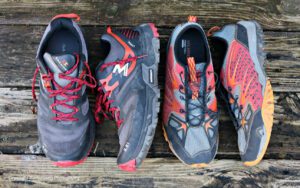
These shoes look similar, but they are very different. The Garmonts, left, have a Gore-Tex liner. The Merrells have a mesh upper and are designed to drain quickly.
It has to do with air pressure. The moisture barrier liners are supposed to let the perspiration out, while keeping the moisture from getting into the shoe. It sounds good but doesn’t work that way. If the air pressure outside is greater – like when it’s raining – you will sweat more than the barrier can let out. If you are exerting yourself at all this will result in wet feet. If you sitting by a campfire and not moving, the moisture barrier may work as advertised.
The original moisture barrier material is Gore-Tex™. I googled this explanation of what Gore-Tex is:
“Gore-Tex is, at its most basic level, a membrane that stops liquid water but allows vapor to pass through. This means Gore-Tex keeps you dry from not just the falling rain, but also the water vapor you make while sweating. The membrane itself made from an expanded polytetrafluoroethylene fiber (also known as Teflon).”
And the moisture barriers might be thin, allowing some sweat to pass through as steam – but “some” is the extent. Bottom line: You sweat far more when exerting yourself than the material can transport out. Your feet will stay wet. I don’t like Gore-Tex rain gear either. Here’s why.
Here is why I don’t like any moisture barrier boot liner.
- Feet sweat. My feet sweat. Your feet sweat. Everybody’s feet sweat. That means your feet will stay moist, and eventually that makes your feet soft. Soft feet blister more easily than dry feet and this leads to sore feet.
Socks can help make a difference. I wear wool socks year round. Wool breathes and the material wicks away moisture. That makes for a cooler, and warmer sock because the moisture is taken out of the scenario.
Cotton, on the other hand, attracts moisture, and once it gets damp, it just keeps getting damper. When cotton is wet, it loses its insulative ability.
- Slow soaking rain will get inside the shoe because of hole at the top where your foot goes in. This may be mitigated through wearing waterproof gaiters or rain pants. But you will still have wet feet, and under these circumstance a moisture barrier shoe won’t help.
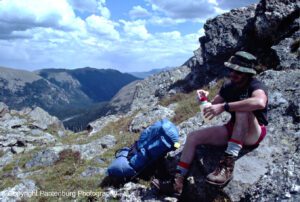
These full-grain leather Lowas worked fine on several extended backpacking trips, despite not being waterproof. (Rocky Mountain National Park, 1986)
Flashback: It rained for nine days and nights when I hiked the 225-mile John Muir Trail in the Sierras. Subsequently, I hiked in the rain much of the time. My eight-inch Georgia logger boots were not waterproofed, but I never had a problem with wet feet. I wore a poncho that covered me and my pack. The water dripped off the poncho’s edges, but didn’t really hit my boots. A waterproof liner in my boots wouldn’t have helped anything.
- Water crossings: In 2004, I went on a nine-day canoe trip through the Boundary Waters Canoe Area in Northern Minnesota. Portages from lake to lake happened several time a day. I ended up carrying a 75-pound canoe over muddy, rocky wet paths. Going barefoot would have been stupid.
So I wore a pair of surplus military jungle boots. These boots are the opposite of waterproof. Made of a mesh upper, they let the water in and then it squishes out on the vented sides. Today, I frequently wear Merrell Capra water shoes when I’m on the Mississippi River with Quapaw Canoe Company. It’s the same philosophy and the shoes are a lot lighter than the boots.
- Takes longer to dry out. This becomes one of those damp versus wet and soggy walking. The breathable, mesh shoes squish out the moisture, and walking in them can create air and water movement, which helps dry out the interior. The barrier liners keep the moisture inside, resulting in a soggy shoe that never really dries out.
- Liners will eventually wear out. At some point, the moisture liner may wear out, causing leaks. This means the shoes won’t dry out, but water will seep in. Essentially, you end up with the worst of both worlds – a non-breathable shoe that leaks.
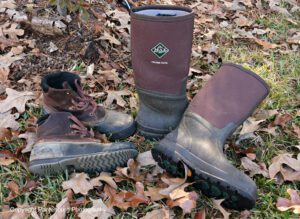
The Sorel rubber bottom, leather top boots (left) work very well for most of my wet ground rambling. The Muck Boots are great for canoe guides.
So what do you wear when it’s rainy weather and you want to keep your feet dry?
Rubber bottom, leather top: The L.L. Bean Maine Hunting Shoe has been standard footwear for wet weather walking for decades. I wore out two pairs of them hunting and hiking in southeastern forests before I moved west.
I also wore a pair in downtown Manhattan during a snow storm, when there was several inches of slush on the sidewalks. In both urban and wilderness situations, the boots perform very well.
Last week, I wore my Sorel™ boots with the rubber bottom, leather tops to work on a cabin restoration in Mississippi. One of my jobs was to carry flooring from the pickup truck, across a shallow (one to two inches deep) creek, to the work site. I waded the creek a couple dozen times, but my feet never got wet. The temperatures were in the low 60s, but between my wool socks and boots, my feet were very comfortable.
Waterproof knee-high rubber boots: These boots are a standard with Big River Wild Adventures. The guides are frequently in and out of the cargo canoes, and without the boots, our feet would be constantly wet and cold. I got a pair of XpressCool™ Muck Boots a couple years ago, and I love them. Any rubber boot will make your feet sweat, but my experience is that the XpressCool boots were cooler and more comfortable than ordinary rubber boots. Combined with quality wool socks, these boots work as well as can be expected.
So do you need a moisture barrier in your boots or shoes?
Obviously, I don’t think so. Unless you are going to be doing a lot of wet weather hiking, there is very little advantage to the moisture barrier linings, IMO, and there are a whole lot of disadvantages.
Make your choices based on what will work for you.
Feedback:
From Jay Thompson: I spent 2 winters in Germany and 6 winters in Korea, along with a couple of jaunts to the winter wonderlands of Alaska, New York, Montana, Vermont, New Hampshire and Washington state. I damn near lost toes due to wearing boots with Gore-tex in them. The reason why was to perspiration condensing inside of my boots. After a 12 to 15 to 21 mile forced march, my boots would fill with condensation vapor, cool down, which then turns the vapor to liquid and in a -28F Korean winter…well blocks of ice would’ve done me better. While Gore-tex and other such materials are, in my opinion, great for jackets and pants, I learned real quick that a good, high quality pair of 100% wool socks are MY best option…your mileage may vary.
From Michel Petiot: Your advice helped me out a lot. Now I educate others about what I learned and what I use. I bought some 511 jungle boots no liner for the summer. Also I have switched to wool socks period. In your book you explained why my feet would sweat so much (boots with liners/goretex) and cotton socks. I will save the Merrells with liner for when it’s wet and cold, this no sweaty damp cold feet.
Please click here to check out and subscribe to the SurvivalCommonSense.com YouTube channel – thanks!

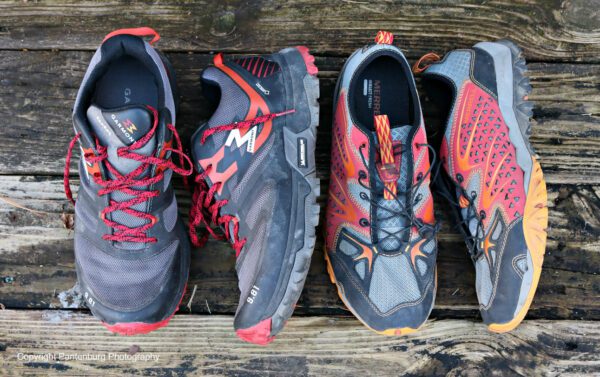


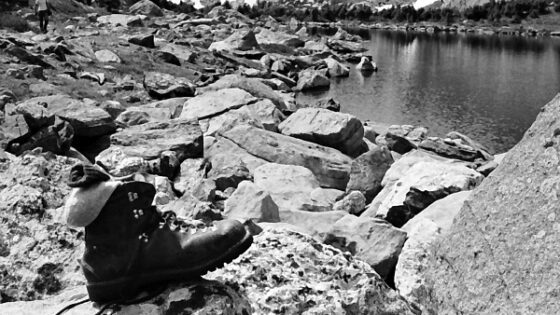
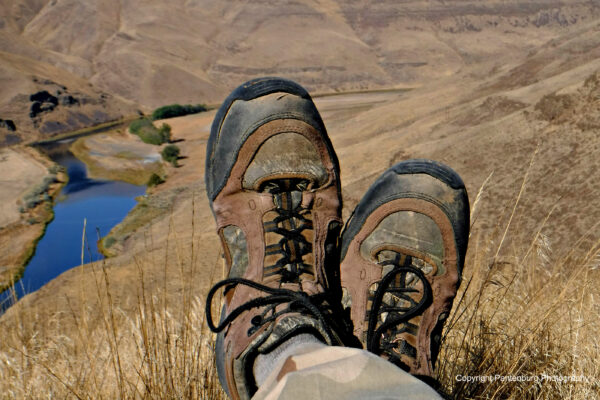
Leave a Reply